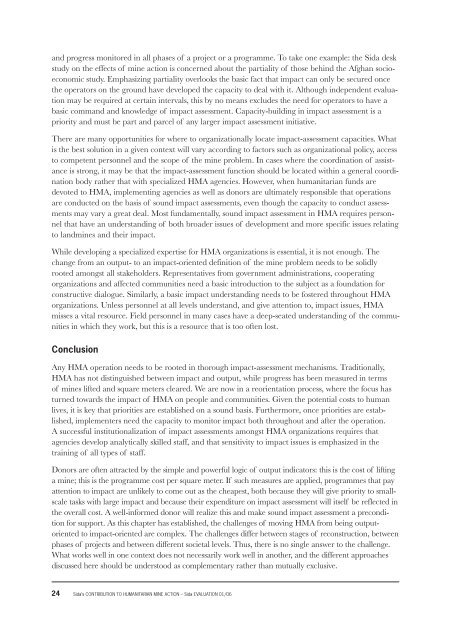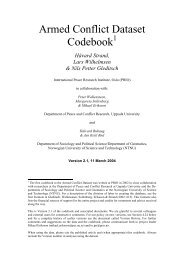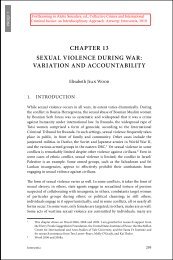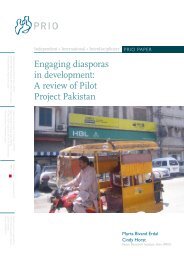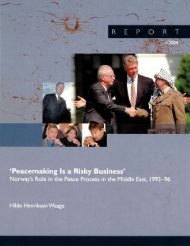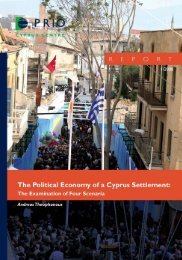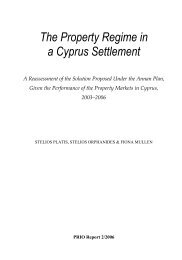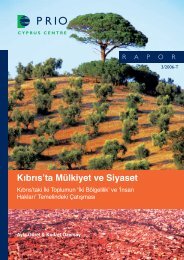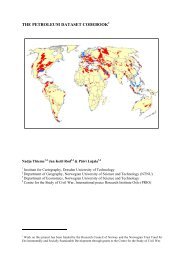Sida's Contributions to Humanitarian Mine Action
Sida's Contributions to Humanitarian Mine Action
Sida's Contributions to Humanitarian Mine Action
Create successful ePaper yourself
Turn your PDF publications into a flip-book with our unique Google optimized e-Paper software.
and progress moni<strong>to</strong>red in all phases of a project or a programme. To take one example: the Sida deskstudy on the effects of mine action is concerned about the partiality of those behind the Afghan socioeconomicstudy. Emphasizing partiality overlooks the basic fact that impact can only be secured oncethe opera<strong>to</strong>rs on the ground have developed the capacity <strong>to</strong> deal with it. Although independent evaluationmay be required at certain intervals, this by no means excludes the need for opera<strong>to</strong>rs <strong>to</strong> have abasic command and knowledge of impact assessment. Capacity-building in impact assessment is apriority and must be part and parcel of any larger impact assessment initiative.There are many opportunities for where <strong>to</strong> organizationally locate impact-assessment capacities. Whatis the best solution in a given context will vary according <strong>to</strong> fac<strong>to</strong>rs such as organizational policy, access<strong>to</strong> competent personnel and the scope of the mine problem. In cases where the coordination of assistanceis strong, it may be that the impact-assessment function should be located within a general coordinationbody rather that with specialized HMA agencies. However, when humanitarian funds aredevoted <strong>to</strong> HMA, implementing agencies as well as donors are ultimately responsible that operationsare conducted on the basis of sound impact assessments, even though the capacity <strong>to</strong> conduct assessmentsmay vary a great deal. Most fundamentally, sound impact assessment in HMA requires personnelthat have an understanding of both broader issues of development and more specific issues relating<strong>to</strong> landmines and their impact.While developing a specialized expertise for HMA organizations is essential, it is not enough. Thechange from an output- <strong>to</strong> an impact-oriented definition of the mine problem needs <strong>to</strong> be solidlyrooted amongst all stakeholders. Representatives from government administrations, cooperatingorganizations and affected communities need a basic introduction <strong>to</strong> the subject as a foundation forconstructive dialogue. Similarly, a basic impact understanding needs <strong>to</strong> be fostered throughout HMAorganizations. Unless personnel at all levels understand, and give attention <strong>to</strong>, impact issues, HMAmisses a vital resource. Field personnel in many cases have a deep-seated understanding of the communitiesin which they work, but this is a resource that is <strong>to</strong>o often lost.ConclusionAny HMA operation needs <strong>to</strong> be rooted in thorough impact-assessment mechanisms. Traditionally,HMA has not distinguished between impact and output, while progress has been measured in termsof mines lifted and square meters cleared. We are now in a reorientation process, where the focus hasturned <strong>to</strong>wards the impact of HMA on people and communities. Given the potential costs <strong>to</strong> humanlives, it is key that priorities are established on a sound basis. Furthermore, once priorities are established,implementers need the capacity <strong>to</strong> moni<strong>to</strong>r impact both throughout and after the operation.A successful institutionalization of impact assessments amongst HMA organizations requires thatagencies develop analytically skilled staff, and that sensitivity <strong>to</strong> impact issues is emphasized in thetraining of all types of staff.Donors are often attracted by the simple and powerful logic of output indica<strong>to</strong>rs: this is the cost of liftinga mine; this is the programme cost per square meter. If such measures are applied, programmes that payattention <strong>to</strong> impact are unlikely <strong>to</strong> come out as the cheapest, both because they will give priority <strong>to</strong> smallscaletasks with large impact and because their expenditure on impact assessment will itself be reflected inthe overall cost. A well-informed donor will realize this and make sound impact assessment a preconditionfor support. As this chapter has established, the challenges of moving HMA from being outpu<strong>to</strong>riented<strong>to</strong> impact-oriented are complex. The challenges differ between stages of reconstruction, betweenphases of projects and between different societal levels. Thus, there is no single answer <strong>to</strong> the challenge.What works well in one context does not necessarily work well in another, and the different approachesdiscussed here should be unders<strong>to</strong>od as complementary rather than mutually exclusive.24 Sida’s CONTRIBUTION TO HUMANITARIAN MINE ACTION – Sida EVALUATION 01/06


